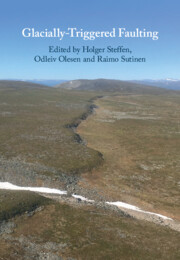Book contents
- Glacially-Triggered Faulting
- Glacially-Triggered Faulting
- Copyright page
- Contents
- Figures
- Tables
- Contributors
- Preface
- Part I Introduction
- Part II Methods and Techniques for Fault Identification and Dating
- Part III Glacially Triggered Faulting in the Fennoscandian Shield
- Part IV Glacially Triggered Faulting at the Edge and in the Periphery of the Fennoscandian Shield
- Part V Glacially Triggered Faulting Outside Europe
- Part VI Modelling of Glacially Induced Faults and Stress
- 22 Glacial Isostatic Adjustment Models for Earthquake Triggering
- 23 Crustal-Scale Stress Modelling to Investigate Glacially Triggered Faulting
- Part VII Outlook
- Index
- References
22 - Glacial Isostatic Adjustment Models for Earthquake Triggering
from Part VI - Modelling of Glacially Induced Faults and Stress
Published online by Cambridge University Press: 02 December 2021
- Glacially-Triggered Faulting
- Glacially-Triggered Faulting
- Copyright page
- Contents
- Figures
- Tables
- Contributors
- Preface
- Part I Introduction
- Part II Methods and Techniques for Fault Identification and Dating
- Part III Glacially Triggered Faulting in the Fennoscandian Shield
- Part IV Glacially Triggered Faulting at the Edge and in the Periphery of the Fennoscandian Shield
- Part V Glacially Triggered Faulting Outside Europe
- Part VI Modelling of Glacially Induced Faults and Stress
- 22 Glacial Isostatic Adjustment Models for Earthquake Triggering
- 23 Crustal-Scale Stress Modelling to Investigate Glacially Triggered Faulting
- Part VII Outlook
- Index
- References
Summary
To model glacial triggering of earthquakes, it is necessary to obtain the spatio-temporal variation of glacial isostatic adjustment-induced stress during a glacial cycled. This can be computed efficiently using commercial Finite Element codes with appropriate modifications to include the important effects of ‘pre-stress advection’, ‘internal buoyancy’ and ‘self-gravity’. The modifications described in Wu (2004) are reviewed for incompressible and so-called materially compressible flat-earths. When the glacial isostatic adjustment-induced stress is superimposed on the background tectonic stress and overburden pressure, the time variation of earthquake potential at various locations in the Earth can be evaluated for any fault orientation. To model more complex slip and fault behavior over time, the three-stage Finite Element model approach of Steffen et al. (2014) is reviewed. Finally, selected numerical examples and their results from both modelling approaches are shown.
Keywords
Information
- Type
- Chapter
- Information
- Glacially-Triggered Faulting , pp. 383 - 401Publisher: Cambridge University PressPrint publication year: 2021
References
Accessibility standard: Unknown
Why this information is here
This section outlines the accessibility features of this content - including support for screen readers, full keyboard navigation and high-contrast display options. This may not be relevant for you.Accessibility Information
- 10
- Cited by
